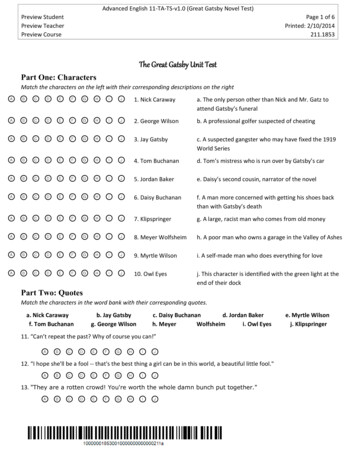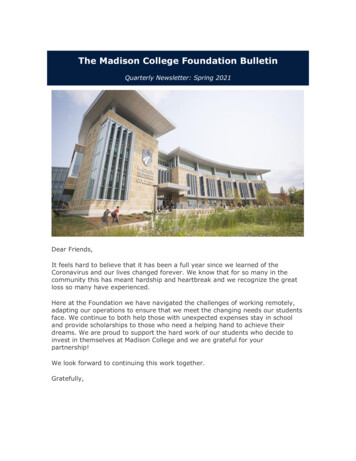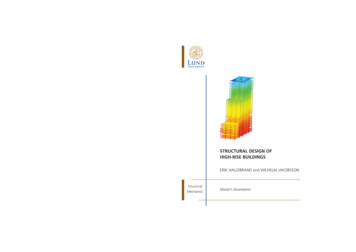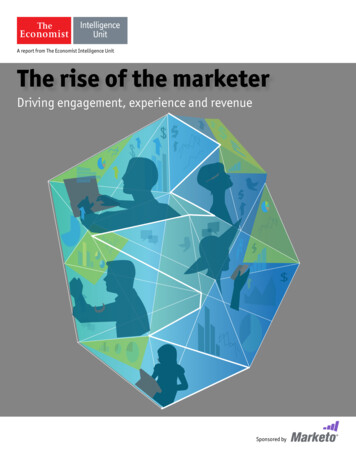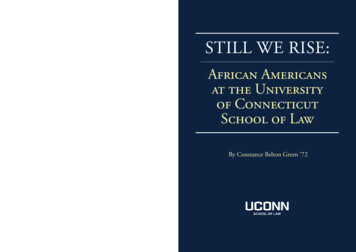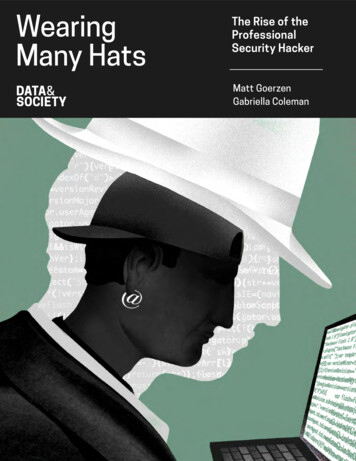
Transcription
WearingMany HatsThe Rise of theProfessionalSecurity HackerMatt GoerzenGabriella Coleman
2 W E ARI N G M AN Y HATS Executive SummaryToday, the global computer security industryis booming, with thousands of well-compensated andwell-respected jobs. And in many cases, these jobs arebeing done by those who self-identify as “hackers”—aterm now openly embraced by many high-profile securityresearchers. This was not always the case, however, andthe professionalization of the hacker figure was far froma foregone conclusion. At the end of the 1980s, many inthe computer security establishment considered hackersto be talented but disreputable criminals—the people theywere trying to secure their systems against. How, then, didthe term “hacker” (and the hackers them selves) make thetransition from security risk to security professional?Wearing Many Hats presents one series of answersto that question, by collecting a previously un-told historyof the 1990s. It was during that period that the figure ofthe hacker underwent a transformation, moving from the“underground” of the 1980s subculture, into the domainof respected employment, favorable media coverage, andcultural status—all of this best symbolized by the 1998testimony of the L0pht before the US Senate. That is, anotorious “hacker crew” dressed in suits and broadcaston TV as various senators applauded their good works ofcitizenship. While the contestation over the hacker identitywas far from resolved, the work of creating a legitimateprofessional role for the hacker had been accomplished.But it had been work. During the decade of the1990s, two primary (and parallel) struggles defined theprocess by which hackers went from underground toprofessionals. The first of these was the negotiation of fulldisclosure, a controversial security procedure, in whichindependent hackers and technologists openly publishedfull accounts of any vulnerabilities they discovered. Ratherthan exploiting these vulnerabilities, or chastely reportingthem to the companies, hackers used full disclosure tosimultaneously develop the technical state of their craftand to pressure software companies into what they saw asmore responsible security practices, ultimately shifting the
3 DATA & S O C I E T Y public perception of computer insecurity.The second major effort was largely non-technical,and was the broad reconfiguration of the hacker imagethrough PR stunts, media collaborations, and rhetoricalinventions. It was during that period that many hackersbegan to evoke imaginary hats. “Black hat” hackers werethose who disregarded the law, “white hat” hackers triedto work inside of it, and “gray hat” hackers (like those thattestified in 1998), lived somewhere in between: touting thetechnical skills of the hacker underground, but willing tosign contracts and work “above” ground.The literal white-and-black morality of these hats,however, can mask ongoing negotiations around ethicalcommitments in computer security. By the early 2000s, therole of the hacker had been successfully professionalized,but the question of just what counted as security—securityfor whom, security from what—remained a point of opendebate. The 1990s professionalization of the hacker classhad set the stage for the next period of struggle over theconcept of security in the modern world.
4Timeline W E ARI N G M AN Y HATS 1950sMIT students coin the term“hacking” to refer to a creativestyle of computer use.1960sThe US military begins“penetration testing” itscomputer systems.1970sEarly 1980sThe US military exploresthe possibility ofdeveloping totally securecomputer systems.The US media beginscalling computerintruders “hackers.”19881990Dorothy Denning andEugene Spafford debatethe merits of employinghackers.A widely disseminatedInternet worm promptsthe establishment of thefirst CERT (ComputerEmergency ResponseTeam) at Carnegie Mellon.A security expert warns US Congressof a possible “Electronic Pearl Harbor.”The US government enactsthe Computer Fraud andAbuse Act, criminalizingunauthorized computeraccess.First issue of hacker e-zinePhrack appears online.199519931991Legion of Doom (LOD) members foundComsec, the first hacker-led computersecurity firm. Met with controversy, itfolds two years later.19851986Mid 1990’sA hacker launchesBugtraq as a mailinglist for the “fulldisclosure” of securityvulnerabilities.Specialized firmsbegin marketingcomputer securityauditing to corporateclients.199819992000@stake hires the L0pht, trumpeting their “grayhat” hacking expertise in promotional material.An IBM vice presidentcoins the term“Ethical Hacking.”The L0pht begins to selfidentify under the bannerof “gray hat” hacking.Hackers begin to collaborate with institutionson “co-ordinated” disclosure policies.The Cult of the Dead Cowreleases Back Orifice, drawingmedia attention and corporate ire.The L0pht testifies to the USSenate about the grave state ofcomputer security.2003Early 2000’sMicrosoft commits toimproving security andbegins to hire “hackers.”2002Bugtraq becomes theproperty of the SymantecCorporation.Specialized firms beginoffering “Ethical Hacking”certification.
5 DATA & S O C I E T Y Table of ContentsExecutive Summary1.0 Introduction02062.0 The Emergence of the Underground(1980s)123.0 Interlude: Safecrackers orSecurity Guards? (1991–1994)254.0 Full Disclosure (1991–2001)285.0 Interlude: Arsonists or Firefighters?(1990–2000)416.0 Public Legitimacy Through MediaWork and Corporate Engagement(1995–2000)437.0 Conclusion: Security by Spectacleand the Limits of Legitimacy63Acknowledgments68Bibliography69
6 W E ARI N G M AN Y HATS 1Steve Morgan, “Cybersecurity TalentCrunch To Create 3.5 Million UnfilledJobs Globally By 2021,” CybercrimeMagazine (blog), October 24, e Morgan, “Global CybersecuritySpending Predicted To Exceed 1 TrillionFrom 2017-2021,” Cybercrime Magazine(blog), June 10, 2019, ket-report/.3For a similar trend in cryptography,whereby the monopoly on encryption heldby the state was broken by another groupof hackers, notably the cypherpunks, seeLevy, Crypto and Greenberg, This MachineKills Secrets.4See Nissenbaum, “Hackers and theContested Ontology of Cyberspace” andSterling, The Hacker Crackdown.5Also known as the “digital underground”or “computer underground.” This termseems to have been emic to the hackersubculture from its creation sometimein the 1980s. “Underground” served asthe go-to term in the hallowed hackerzine Phrack to describe both particularhackers and the scene in which theyparticipated. The following descriptionis typical of how the term was used:“Taran King is back for a special PhrackPro-Phile with Lex Luthor, the founderof the Legion of Doom and perhaps themost legendary underground hacker ever,”See: Dispater, “Phrack #40 File 1 of14,” Phrack, August 1, 1992, http://www.phrack.org/issues/40/1.html.6Rosalie Steier, “News Track: Just SayNo,” Communications of the ACM, May1990.1.0 IntroductionThe computer security industry is booming. Jobs are bountifuland profits are high. Security companies in the United States, Australia,Israel, and elsewhere are desperate to hire talent. Between 2019 and2020, 715,000 people held cybersecurity positions in the United Statesalone, and another 314,000 positions were unfilled.1 Industry analystsdescribe growth in the cybersecurity market as “stratospheric,”estimating its worth will reach US 170.4 billion in 2022.2 One of thepremier professional security conferences, Black Hat, declared anotherrecord-setting year in 2019, with more than 20,000 attendees. Itscommunity-driven counterpart, DEF CON, attracted an estimated30,000 participants.While “security researcher” is a common title for thoseworking in this industry, many of these technologists also openlycall themselves “hackers.”3 But a few decades ago, very few firms,government agencies, or companies offering services in computersecurity were willing to openly hire hackers—or admit to hiring them.Indeed, in the 1980s and for much of the 1990s, while many in the“underground” hacking scene proudly embraced the hacker label,the hacker figure was nothing if not controversial. In the mainstreammedia, popular culture, and even government circles, “hacker”designated a particular type of computer criminal who broke intosystems, stole data, and caused serious damage.4The 1980s and 1990s generations of these undergroundhackers frequently communed in exclusive and secretive associations,digitally picking every lock they could find to roam the internet’snooks and crannies. They treated computer infiltration like a sport,identifying vulnerabilities, honing new techniques, and writing up theexploits necessary to come and go as they pleased, frequently sharinginformation with their peers. They contributed to a growing body ofknowledge, a decentralized but collective culture replete with localcustoms, de facto norms, and reputational appraisals: the hackerunderground,5 or simply “the scene,” as insiders often called it.Even if potential employers believed these hackers heldadvantageous technical skills—and many did—their outlaw statusraised serious questions about their trustworthiness. Indeed, in theearly 1990s, esteemed academic critics even advised the fledglingcomputer security industry to steer clear of hiring any technologistwilling to break into systems.6 How, then, did perceptions of that classof hacker go from untrustworthy and suspicious to valued computersecurity experts, not only entering the computer security industry asprized workers, but also having fundamentally shaped contemporarycybersecurity norms and protocols? When did hackers become a
778 DATA & S O C I E T Y The question of expertise andprofessional legitimacy form atouchstone in the anthropology andsociology of science and technologystudies (see Ballestero, A FutureHistory of Water; Boyer, “Thinkingthrough the Anthropology of Experts”;Folch, Hydropolitics; Merry, TheSeductions of Quantification; Hull,Government of Paper; Hetherington,Guerrilla Auditors; Riles, FinancialCitizenship; Ho, “DiscipliningInvestment Bankers”). One of thecanonical texts in this corpus is StevenEpstein’s work on “lay expertise.”(Epstein, Impure Science and Epstein;“The Construction of Lay Expertise”).His work examines not only how ACT UPactivists and HIV patients acquired theknowledge necessary to contribute tothe science around medical treatment,but credibility as legitimate andtrustworthy participants. This reportis indebted to Epstein’s framing,even as it provides a counter-exampleto aspects of his study; unlike thelay-experts he examines, the hackersprofiled here often held equal or evengreater knowledge about some aspects ofsecurity as established experts. Butlike Epstein’s lay-experts, hackersstill faced the need to establish theirprofessional legitimacy given lackof credentials and often engagementin legally fraught activities. Likethe lay-experts, those hackersinterested in engaging with the fieldof computer security had to walk afine line: simultaneously antagonizingthe establishment (to contest theircharacterization) and exhibiting awillingness to work in a professionalsetting.For instance, Dave Buchwald (“Bill FromRNOC”), a member of the Legion of Doom(LOD), served as a technical consultanton the 1995 movie Hackers. The movieportrays a diverse group of New YorkCity-based underground hackers, whocome together through various hackingexploits. They struggle to foil acomputer security officer’s plans todefraud his employer and frame theprotagonists for the deed.source of security, rather than its (perceived) enemy? In other words,how did hackers legitimize their craft?The answers to these questions are tied up in a history thatnot only involves computer networks and software security, but alsorhetorical flourishes, public stunts, and clever PR. In some ways, theseefforts are symbolized by a struggle over the color of imaginary hats;during the 1990s, many of those interested in the security of computernetworks began to signal their relationships to laws and norms with anew set of jargon that channeled, at first, an ethical binary: “white hat”hackers tried to work with companies and governments to legitimatethemselves as security experts whose skills could help improve systemsand keep users safe, while “black hat” hackers were proud to floutlegal protections, to hack for their own ends, and to keep undergroundknowledge about security vulnerabilities within their community. Andwhile the imagery of white and black hats channels a stark morality ofgood and bad, the reality is far more complicated. In fact, by the endof the 1990s, a subset of hackers claimed a third shade; “gray hat”hackers claimed to offer the best of both worlds—their associationswith the hacker underground maintained their subcultural credibilityand access to exclusive security knowledge, but they were also willingto leave the shadows, sign contracts, and work with companies andgovernments.This report is foremost concerned with what undergroundhackers did—technically, linguistically, and culturally—to establishtheir legitimacy as employable, trustworthy security experts.7 Therewas no single coordinated plan of legitimization—and indeed, manyhackers did not understand their activity in this conceptual frame—but countless individuals and influential hacker “crews” worked inparallel, demonstrating skill by developing novel attack and auditingmethodologies, refining processes of disclosure, and reforming theircollective image. They educated journalists about their technicalcraft and virtuous intentions, launched media campaigns, engagedin linguistic re-engineering, or deployed linguistic code switching toobfuscate their past deeds. A few even sought to cultivate sympatheticpop cultural representations.8 Looking back, we can see two significantinterventions as exemplary of these legitimization efforts.The first key intervention centered on the advocacy andpractice of an informal security protocol called “full disclosure.” Fulldisclosure rebuked the popular practice, then prevalent among bothestablishment tech organizations and the hacker underground, ofkeeping information about computer insecurity carefully siloed andout of the public view. The most pointed engagement in full disclosureoccurred on a mailing list called Bugtraq, started in 1993 as a platformfor hackers and researchers operating outside of institutional confinesto publicly document and publicize newly discovered technical vulnerabilities. In doing so, Bugtraq created a space for hackers interested incourting legitimacy as security researchers to dialogue and communewith institutionally aligned technologists and others convinced that
89 W E ARI N G M AN Y HATS “The L0pht, Renowned ‘hacker ThinkTank,’ to Join @stake: Receives 10Million in Initial Backing fromBattery Ventures,” @stake Events &News (archive.org capture), January6, 2000, www.atstake.com/events news/press releases/launch.html.10 For more on the varying wayshackers approached the prospect ofprofessionalization, see: NicolasAuray and Danielle Kaminsky, “TheProfessionalisation Paths of Hackersin IT Security: The Sociology ofa Divided Identity,” Annales DesTélécommunications, 62 (2007): 1312–26.public discussion was conducive to the improvement of security.The second key intervention was rehabilitating the publicimage of the hacker, in order to undo the criminal associations of the1980s underground. Hackers rebuilt their moral credibility through arange of linguistic, rhetorical, and mediatic labor. That involved coiningterms like “gray hats,” but also strategically interfacing with journalists,developing controversial software tools, and launching sophisticatedcampaigns designed to vilify software vendors, most notably Microsoft.These efforts were assisted by allies, inside and outside of the USgovernment, who saw some of these hackers as noble security expertsadvocating for the public interest—and sometimes underscoringconcerns of growing import to the national security establishment.Owing in part to these interventions, hackers ultimatelybecame respected, frequent fixtures in conversations about computersecurity. That legitimacy became nearly incontrovertible in 1998, whenthe United States Senate invited seven hackers—part of a group calledthe L0pht—to testify to the pressing need for greater attention tocomputer security. Not long after, in 2000, the same group joined afreshly minted computer security firm called @stake. The companyboasted in PR material of their merger with a “renowned hackerthink-tank.” As they put it, “This strategic move reflects the firm’scommitment to build a world-class team of professionals offering nontraditional, e-commerce-age security solutions for clients.”9By the turn of the millennium, formerly vilified hackers gainedthe potential to occupy legitimate—even privileged—roles in securitycompanies and institutions.10 Against the backdrop of the late-’90sdotcom boom, then the specter of the Y2K problem, and subsequentlya post-9/11 security obsession and the steady rise of e-commerce,many hackers found a welcome home in a booming security sectorshaped, in part, by their earlier interventions. Many joined companies,while others started their own, or served as consultants in both thepublic and private sector.This report details how hackers were able to redeem theirimage sufficiently for many of them to be deemed trustworthy expertsand employees of governments and corporations. Still, even if theywere able to help define and participate in the public-interestedpursuit of securing technology, the security methods and imperativesthat consolidated in the 2000s were also narrow in scope; their focuswas overwhelmingly on technical matters, like finding and patchingvulnerabilities. Other types of social insecurity and risk stemming fromthe use of networking technologies—such as harassment, surveillance,and the targeting of civil society activists—were only substantiallyaddressed later by different types of communities and actors. Thelack of diversity in the underground scene and the early securityindustry—both populated overwhelmingly by white men—might havealso precluded a more expansive vision of what technological securityentails, an issue we raise in our conclusion and will engage with more
9 DATA & S O C I E T Y 11 Other studies have laid out dynamicsin the hacker scene of the 1980s andearly 1990s: See for instance Sterling,The Hacker Crackdown; Thomas, HackerCulture; Jordan, Cyberpower.12 Chan, Anita Say. Networking Peripheries:Technological Futures and the Myth ofDigital Universalism. MIT Press, 2013.substantially in a subsequent report.This report is based on 23 formal ethnographic interviews,dozens of informal interviews, and analysis of archival data (Usenet andmailing list posts, reportage, recorded conference talks, advisories, textfiles, books, technical journal articles, and other documentation), andconcentrates on the period between 1991 and 2001.11 While we focuson hacking in the US context, some of our interview subjects cameof age in European hacker communities, interfacing increasingly withUS hackers as the internet expanded. The dynamics at play in otherWestern countries were often similar, but different in notable ways thatwe leave outside the scope of this study. Likewise, the question of howhacking in what Anita Say Chan has called “peripheries” relates to thestory of visibility and legitimization told here is a subject worthy of moreattention.12The body of this report is divided into three sections withtwo interludes. Following this introduction and a brief discussion ofkey terminology section 2, “The Emergence of the Underground,” setsthe stage for the rest of the report by summarizing some foundationalaspects of the 1980s and early 1990s hacker scene, such as hackermotivations, demographic attributes, and subcultural dynamics.Section 3 serves as a brief interlude describing the resistance thattwo professionally minded hackers met in the early 1990s, providingcontext for the hacker-led interventions discussed in the remainder ofthe report. In section 4, we explore the significance of the controversialfull disclosure approach to security research, focusing on the historyof the Bugtraq mailing list, launched in 1993. Section 5, our secondinterlude, showcases the polarized tenor of the debate regardinghacker motivations and trustworthiness in the early 1990s. Section 6covers how hackers built moral credibility by castigating the negligenceof big corporations and courting media attention, as well as the roleplayed by hacker allies in government, the academy, and the nonprofitsectors, who worked alongside hackers to help refashion their image.The history of legitimization explored in this report is notthe full story. Some participants in the computer underground wereless than thrilled by the incorporation of hackers into the computersecurity establishment. Some fought back, maligning those deemedas white hats, and even hacking some of them to cast aspersions ontheir capabilities. Many already-professionalized security researchersremained suspicious of the hacker newcomers and their methods.And offshoots of the 1990s hacker underground, including hacktivistsand political activists, would challenge the very notion that technicalimprovements to security necessarily served the interests of the public.Nevertheless, this account offers some insights into the wayshackers gained public legitimacy, and also helps us ask larger questionsabout security. How are issues nominated as matters of concern?Whose perspectives mattered and why? How might those left outsidethe security establishment continue to influence the security agenda?
10 W E ARI N G M AN Y HATS What does it mean that a domain so consistently equated withtechnical matters relied on social processes, such as media spectacleand extra-institutional collaboration?We briefly take on these questions in our concluding remarks,as they stem from the history we now turn to.1.1Hacker TerminologyFirst, it is worth establishing some core terminology. As willshortly become clear, nearly every term used in computer securitydiscourse—not only hacker—is contested and polysemic, marked bya distinct valence tied to a given community of use. As such, in ourreport, we spend considerable time on linguistic politics, examininghow and why different actors deployed terms like “hacker,” “white hat,”and “gray hat,” among others, to make claims about skills, disposition,and moral worth. Alongside analyzing such terminology, we alsodefault, at times, to using the term “hacker” in a more descriptiveregister, as it was so commonly used by our interview subjects.Indeed, we typically use the term “hacker” in its broadestsense: referring to those technologists who self-identified as suchand were involved in various specific hacker subcultures of the 1980sand 1990s, and also those technologists interested in learning aboutcomputer security in a hands-on manner, typically outside of anyinstitutional remit.13 Levy, Hackers.14 The term was coined circa 1985 “byhackers in defense against journalisticmisuse of hacker,” according to theJargon File—a vast compendium of hackerterminology. “Though crackers often liketo describe themselves as hackers, mosttrue hackers consider them a separateand lower form of life. An easy wayfor outsiders to spot the differenceis that crackers use grandiose screennames that conceal their identities.”Eric Raymond, “Cracker,” The Jargon File(version 4.4.7), December 2003, tably, the term “cracker” was alsoadapted by subcultural technologists,as a label for hackers focused on copyprotection circumvention, a foundationalaspect of software piracy (also known as“warez”).15 Phil Lapsley, Exploding the Phone:The Untold Story of the Teenagers andOutlaws Who Hacked Ma Bell (New York:Grove Press, 2013).That said, it is useful to offer a bit of context about theterm’s specificity for different communities of use. Many technologistsworking with computers in the 1980s modeled themselves as “hackers”in the mold of those Massachusetts Institute of Technology (MIT)students who first adopted the label in the 1950s to characterizetheir brand of creative, explorative computer use.13 But those 1980scomputer users focused on breaking into systems also saw themselvesas “hackers.” As journalists latched on to the term to describe thesedigital rapscallions, the more high-minded technologists beganreferring to them as “crackers.”14For their part, those hackers interested in breaking intosystems often further qualified themselves as “underground hackers”or participants in the “hacker scene,” “computer underground,” “digitalunderground,” “hacker underground,” or perhaps most commonly,simply “the scene.” Some of these hackers were even more specific,referring to their subculture as the “H/P (Hack/Phreak) Scene,” the“HPAVC (Hack/Phreak/Anarchy/Virus/Carding) Scene,” or a relatedvariant. The term “Phreak,” common in hacker publications like Phrack,was inherited from the 1970s “phone phreaks,” who spent timediscovering ways to exploit pre-digital phone systems.15 The additionof “Anarchy/Virus/Carding” signifies the overlap with subculturallyadjacent activities with their own histories: the writing and distributionof anti-establishment text files, the exploration of computer viruses,
11 DATA & S O C I E T Y and the exploitation of long-distance calling cards.Adding to the complexity of the term “hacker” was theemergence of technologists outside “the scene”—computer scientists,programmers, and systems administrators, among others—who werealso invested in learning about computer insecurity. Some of thesefigures identified as hackers, while others did not; for those outside“the scene,” the term “hacker” was often treated as a marker ofabove-average technical ability, and had nothing to do with computer(in)security.Where possible, we have also attempted to clarify anyambiguities by using terms like “underground hackers,” “institutionalsecurity researchers,” and “technologists.” But even these distinctionsare unsatisfying for a variety of reasons, not the least of which isthe dynamic we are most interested in here: the legitimization, andultimately professionalization, of the underground hacker. Thattransition often witnessed underground hackers identifying assecurity researchers while still maintaining their hacker identity andunderground status. For the above reasons, we sometimes use theterm “security hackers” to characterize those figures for whom aninterest and involvement in hacking served as an entry route to thebroader computer security field.16 Other distinctions became salient afterour period of study, mostly tied toprofessional areas of expertise (as in“offensive security” and “defensivesecurity”), scene status (as in“active”) or political orientation(as in “hacktivist”), and will not beaddressed in depth in this report.It is tempting to see the subsequent typology of “hats” asfurther clarifying these complexities; in the 1990s, the labels “white hathacker” and “black hat hacker” became popular as a way to distinguishbetween those hackers interested in using hacking-derived knowledgeand techniques to enhance the security of digital infrastructure, andthose hackers interested in hacking for dubious, malicious, or selfinterested reasons. But in many instances, these qualifications onlymuddied the water further: was the application of hacker knowledgeto enhance a client’s security not also a type of self-interest? And whatabout those cases in which “black hat” methods were essential forrevealing the insecurity in the first place? Some treated “white hat” asa term for establishment-aligned professional security workers. Otherstreated it as a label for any hacker perceived to be operating in thepublic interest. Others still leaned into the term “black hat,” embracingit to signal dissatisfaction with the commodification of undergroundknowledge—using “white hat” as a pejorative shorthand for “sellouts.”Moreover, many hackers who would be identified as “black hat” inone aspect of their lives had quietly gone to work as “white hats” forearly computer security companies, keeping their pseudonymousnonprofessional lives secret, even as they drew on the knowledgegleaned in one context to inform the other. And as we discuss in depthin section 6, some hackers advanced the term “gray hat” to recognizethese ambiguities. For these reasons and more, we analyze thesehacker-hat terms as historically important rhetorical material, but donot ourselves draw on them as a useful tool for qualifying particulartypes of hacker activity.16
12 W E ARI N G M AN Y HATS 17 See: Sterling, The Hacker Crackdown;Meyer, “The Social Organization of theComputer Underground”; Assange andDreyfus, Underground.18 Lapsley, Exploding the Phone.19 See Sterling, The Hacker Crackdown;Driscoll, “Social Media’s Dial-UpAncestor”; Driscoll, “Demography andDecentralization.”2.0The Emergence of theUnderground (1980s)The hacker “underground” community of the 1990s and early2000s owed a tremendous amount to what has been variously calledthe “digital underground,” “computer underground,” or “H/P (hack/phreak)” scene of the 1980s.17 Made up of hackers and phone phreaks,the underground consisted of technologists who banded togetherinto small and secret associations of various kinds, focused on gainingaccess to phone or computer systems. In the 1980s, long before theadvent of the publicly accessible internet, the phone network wasking—whether as a direct object of exploration, as for the phonephreaks,18 or as a means to connect to Bulletin Board Systems (BBSes)or Private Branch Exchanges (PBX).19Indeed, in the 1980s (and well into the 1990s), much of theunderground’s activit
An IBM vice president coins the term Legion of Doom (LOD) members found “Ethical Hacking.” . while the imagery of white and black hats channels a stark morality of good and bad, the reality is fa



